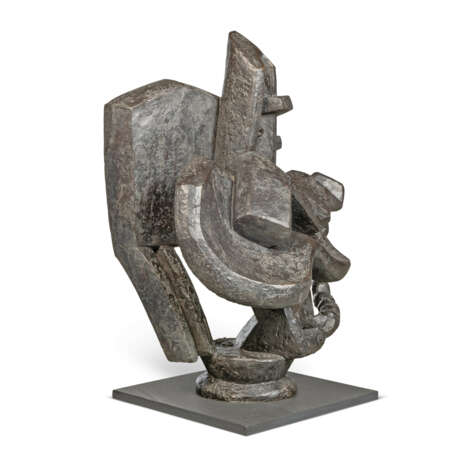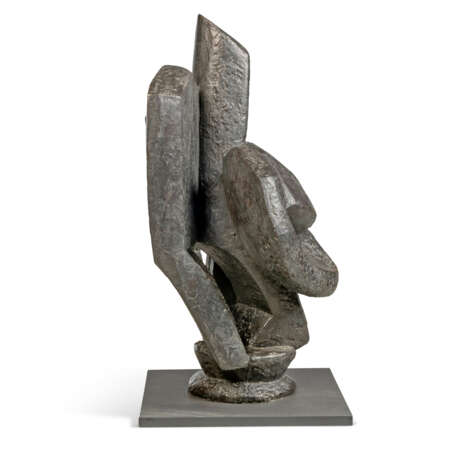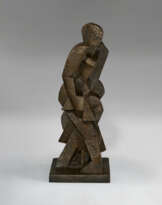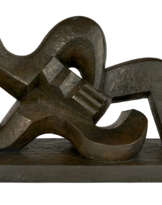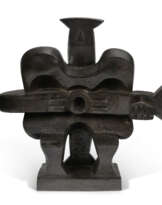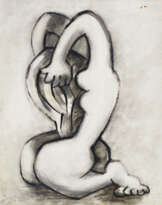ID 929956
Лот 174 | Jacques Lipchitz (1891-1973)
Оценочная стоимость
€ 100 000 – 150 000
Musical Instruments
signé et numéroté '5/7 Lipchitz' (sur la base)
bronze à patine brun foncé
Hauteur: 83.7 cm.
Conçu en 1925; cette épreuve fondue avant 1973 dans une édition de 7 exemplaires
signed and numbered '5/7 Lipchitz' (on the base)
bronze with dark brown patina
Height: 33 in.
Conceived in 1925; this bronze cast before 1973 in an edition of 7
Provenance
Marlborough Galleries, Londres.
Acquis auprès de celle-ci par le propriétaire actuel en juin 1973.
Literature
Jacques Lipchitz, Sculptures and drawings, cat. exp., Marlborough Galleries, Londres et Zurich, 1973, p. 53, no. 15 (une autre épreuve illustrée en couleurs).
A. G. Wilkinson, The Sculpture of Jacques Lipchitz, A Catalogue Raisonné, The Paris Years, 1910-1940, Londres, 1996, vol. I, p. 219, no. 178 (une autre épreuve illustrée, p. 71).
Special notice
Artist's Resale Right ("droit de Suite").
If the Artist's Resale Right Regulations 2006 apply to this lot, the buyer also agrees to pay us an amount equal to the resale royalty provided for in those Regulations, and we undertake to the buyer to pay such amount to the artist's collection agent.
ƒ: In addition to the regular Buyer’s premium, a commission of 5.5%
inclusive of VAT of the hammer price will be charged to the buyer.
It will be refunded to the Buyer upon proof of export of the lot
outside the European Union within the legal time limit.
(Please refer to section VAT refunds)
This item will be transferred to an offsite warehouse after the sale. Please refer to department for information about storage charges and collection
details.
Post lot text
Les années 1920 marquent un tournant décisif dans l’œuvre de Jacques Lipchitz. Ayant mis fin à sa collaboration avec la galerie de Léonce Rosenberg en 1920, le sculpteur lituanien se rapproche du galeriste Daniel-Henry Kahnweiler et profite chez lui de dimanches entourés de l’avant-garde artistique et littéraire parisienne. Lipchitz sera effectivement proche de nombreux artistes à l’instar de Juan Gris, Jean Metzinger, mais aussi de Jean Cocteau, André Salmon ou encore de Max Jacob par exemple. L’émulation artistique qu’il vit est telle que l’artiste écrira dans ses mémoires « nous parlions la même langue et explorions la même langue et explorions le vocabulaire de cette langue ensemble » (J. Lipchitz, My Life in Sculpture, New York, 1972, p. 40).
En 1925 Lipchitz s’installe à Boulogne dans son atelier construit par Le Corbusier, et se rapproche ainsi des trente-deux autres ateliers de sculpteurs boulonnais. Cette époque de renouvellement incite le sculpteur a innover et à renouveller son esthétique cubiste, auparavant guidée par les préceptes de Georges Braque et de Pablo Picasso : « J'avais travaillé, dans les années précédentes, autour d'une forme d'expression toujours plus solide et monumentale. Soudain, je me retrouvai jouant avec l'espace, avec une sorte de construction ouverte, lyrique, qui agit sur moi comme une révélation ». (ibid, p. 86).
C’est ainsi que Jacques Lipchitz développe ses « transparents », ses sculptures curvilignes en bronze mêlant masse solide et espaces ouverts. Musical Instruments illustre parfaitement la rencontre entre la réflexion qu’il explore et son thème de prédilection, la musique : « Les tentatives d'élision et de distorsion déjà exprimées dans sa sculpture cubiste trouvent là une sorte d'aboutissement lyrique, évoluent en courbes mélodiques qui invitent à entrer dans le mystère plastique ». (M. Lefrançois in Lipchitz, Les années françaises 1910-1940, cat. exp., Boulogne-Billancourt, 2005, p. 29).
La musique est par ailleurs une thématique très personnelle pour l’artiste, avant d’être une iconographie profondément cubiste : « Comme les peintres cubistes, je collectionnais les instruments de musique et en décorais mon atelier. Nous utilisions ces objets, qui faisaient partie de notre quotidien, comme une sorte de réaction contre les sujets nobles et exaltés des académiciens » (J. Lipchitz, My Life in Sculpture, New York, 1972, p. 57).
Ainsi, Musical Instruments incarne l’association de différents enjeux stylistiques et personnels pour l’artiste, association qui marquera le début d’une réflexion qui lui sera propre. Ce dépassement du cubisme trouva écho chez ses pairs, par exemple chez Le Corbusier et Robert Mallet-Stevens, qui lui confirent de nombreuses commandes, ou encore chez Pablo Picasso, qui visita notamment son atelier en 1927 et 1930.
The 1920s marked a decisive turning point in the work of Jacques Lipchitz. After ending his collaboration with Léonce Rosenberg's gallery in 1920, the Lithuanian sculptor approached the gallery owner Daniel-Henry Kahnweiler and enjoyed Sundays surrounded by the Parisian artistic and literary avant-garde. Lipchitz was close to many artists, including Juan Gris and Jean Metzinger, as well as Jean Cocteau, André Salmon and Max Jacob. The artistic emulation he experienced was such that the artist wrote in his memoirs, "we were all working with a common language and exploring the vocabulary of that language together." (J. Lipchitz, My Life in Sculpture, New York, 1972, p. 40).
In 1925, Lipchitz moved to Boulogne to his studio built by Le Corbusier, joining the other 32 sculptors' studios in Boulogne. This period of revival encouraged the sculptor to innovate and revise his Cubist aesthetic, previously guided by the instructions of Georges Braque and Pablo Picasso: "In previous years I had worked on an ever more solid and monumental form of expression. Suddenly, I found myself playing with space, with a kind of open, lyrical construction that was a revelation to me." (ibid, p. 86).
This is how Jacques Lipchitz develops his "transparents” – curvilinear bronze sculptures combining solid mass and open spaces. Musical Instruments is a perfect example of the convergence between his reflections and his favourite theme, music: "The attempts at elision and distortion already expressed in his Cubist sculpture reach a sort of lyrical outcome here, evolving into melodic curves that invite one to enter the plastic mystery." (M. Lefrançois in Lipchitz, Les années françaises 1910-1940, cat. exp., Boulogne-Billancourt, 2005, p. 29).
Music is a very personal theme for the artist, as well as deeply Cubist in terms of imagery: "Like the Cubist painters, I collected musical instruments and decorated my studio with them. We used these objects, which were part of our daily landscape, as a kind of reaction against the noble, exalted subjects of the academics." (J. Lipchitz, My Life in Sculpture, New York, 1972, p. 57)
Thus, Musical Instruments embodies the combination of various stylistic and personal themes for the artist, which marked the beginning of his own reflection. This overcoming of Cubism was echoed by his peers, including Le Corbusier and Robert Mallet-Stevens, who commissioned him on numerous occasions, and Pablo Picasso, who visited his studio in 1927 and 1930.
| Автор: | Жак Липшиц (1891 - 1973) |
|---|---|
| Техника исполнения: | Металлоконструкция |
| Материал: | Бронза |
| Автор: | Жак Липшиц (1891 - 1973) |
|---|---|
| Техника исполнения: | Металлоконструкция |
| Материал: | Бронза |
| Адрес торгов |
CHRISTIE'S 9 Avenue Matignon 75008 Paris Франция | ||||||||||||||
|---|---|---|---|---|---|---|---|---|---|---|---|---|---|---|---|
| Предосмотр |
| ||||||||||||||
| Телефон | +33 (0)1 40 76 85 85 | ||||||||||||||
| Факс | +33 (0)1 40 76 85 86 | ||||||||||||||
| Условия использования | Условия использования | ||||||||||||||
| Транспортировка |
Почтовая служба Курьерская служба Самовывоз | ||||||||||||||
| Способы оплаты |
Банковский перевод | ||||||||||||||
| Часы работы | Часы работы
|

